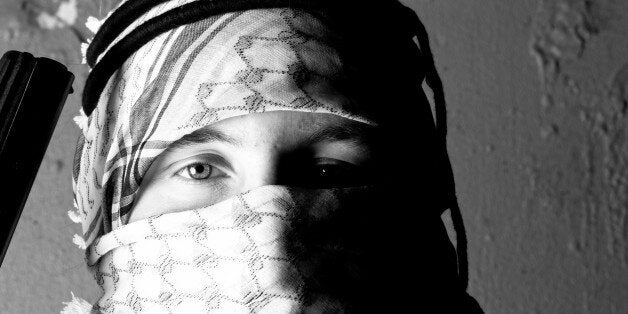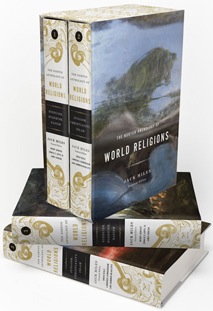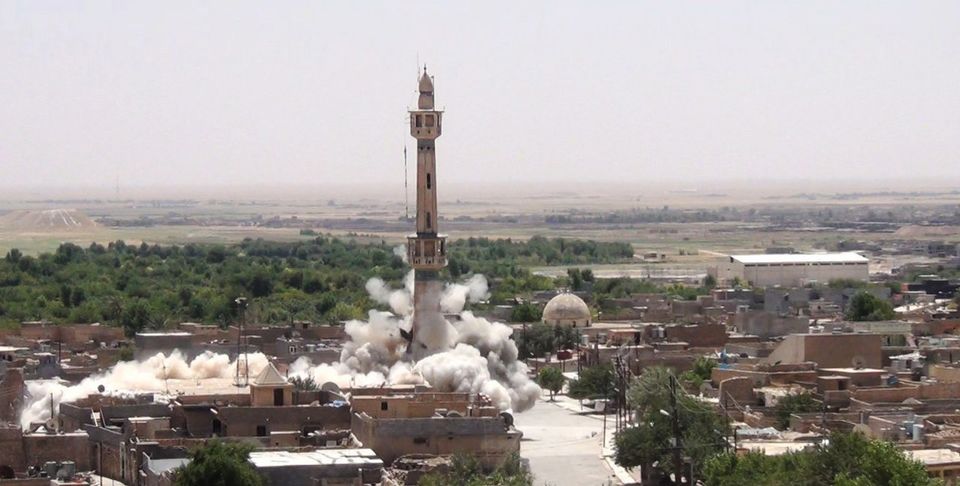
A war within Islam, among radical Islamists and Muslim sects Sunni and Shia, is leaving thousands dead and millions displaced.
The spectacle of so many Muslims prepared to make bloody, protracted war over their slight religious differences strikes Americans as not merely horrifying but also simply baffling. Why do they do that?, we find ourselves asking, and, perhaps more urgently, Where will this end?
One good way to engage these questions is to ask why we don't do that. That we do not ought rightfully to surprise us because as a people we care intensely about religion, on the one hand, and, on the other hand, we do not in the least shrink from violence. The U.S. is both the most religious of highly developed states, given our high rate of religious affiliation and participation, and the most violent, given our astronomically high rate of death by armed violence. Why is it then that we, who are statistically so ready to gun each other down for other reasons, do not do so for religious reasons?
THEN: CATHOLIC VS. PROTESTANT. NOW: SUNNI VS. SHIA
The answer is rooted in our origin as a state descended from a group of Christian colonies founded when the Protestants and Catholics of Western Europe, emphatically including the British Isles, were tearing themselves apart over religion and wrecking the infrastructures of their own countries in the process, just as the Sunni and Shia are doing in Iraq and Syria today.
We are appalled at the spectacle of a beheaded American reporter. Imagine how appalled we would be at the spectacle of a beheaded American president. But just that was the spectacle that the Calvinists (Puritans) of Britain mounted for the edification of their country when they beheaded the Anglican King Charles I in 1649. That execution came midway in a religious civil war that lasted fully nine years (1642-1651) and cost Ireland (which suffered a reign of terror comparable to that of ISIS) and Britain more lives, proportionately, than the two islands would lose in World War I.
Devastating as the English Civil War was, its violence is dwarfed by that of the contemporary Thirty Years War (1618-1648) on the European continent. That warbegan as a regional struggle in Bohemia, quite like the localized Sunni-Alawite conflict in Syria, but it ended with Europe in flames from the Baltic Sea to the Mediterranean. If Turkey and Iran are both drawn into the current Middle East conflict, that conflict will have spread similarly from the Aegean Sea to the Persian Gulf. The near-total collapse of civil society in the worst-affected parts of Europe during the early seventeenth century led to plague as well as famine, just as the spreading conflict in the Middle East and Pakistan has brought about a recurrence of polio.
"Just as Catholics and Protestants concluded in their Wars of Religion, Sunni and Shia have to exhaust one another before concluding that neither side can determine what their religion is to be."
Today, the confusing official and unofficial Sunni and Shia alliances of the U.S. leave many in the Middle East asking, "Which side are you on?" Because Shia Iraq supports semi-Shia Syria, which the U.S. opposes, many Iraqi Shia believe that the U.S. has created the Sunni "Islamic State" (ISIS) so as to undo semi-Shia rule in Syria, even at the price of undermining Shia dominance in Iraq. Meanwhile, many Sunni -- observing that in Iraq the U.S. has installed and still supports the first Shia Arab regime in centuries and has been actively seeking to improve relations with Shia Iran -- conclude that the Americans have declared war on "Islam" itself inasmuch as the only true Islam for them is the Sunni version. At cross-purposes like these, the U.S. is, to say the least, ill positioned to rally a nonsectarian, Sunni-Shia coalition against ISIS. And yet President Obama's core assumption -- that only Sunni and Shia can resolve their own war with one another -- is surely correct.
But will they? Intra-Christian violence was no less bewildering than intra-Muslim violence is today. Catholic monarchs sometimes ended up supporting Protestants against other Catholics, and vice versa, as the originating religious issues disappeared in the melee of attack and counter-attack and the standard agendas of power politics surged to the fore. When Catholic France turned against Catholic Austria, the tie-breaking outsider -- corresponding to the tie-breaking U.S. in the Mideast conflict -- was the Ottoman Empire.
Perhaps most important, just as Sunni and Shia today refuse to recognize one another as equally Muslim, so Protestants and Catholics back then refused to honor one another as equally Christian. Then as now, polemical rhetoric was blood curdling, and public executions were a theatrical part of the mutually intimidating propaganda. Then as now, each side saw its own killers as saints, and its own casualties as martyrs, while denying any such dignity to the pagans or heretics of the other side. Just as Sunni flee Shia-held areas in today's Iraq and Syria while Shia flee Sunni-held areas, so did Catholics and Protestant civilians flee one another en masse during (and after) the Thirty Years War.
Before it was all over, the population of Greater Germany -- then a central European region substantially larger than the relatively compact Germany of today -- had declined by more than one third. Other regions suffered only somewhat smaller losses. Not until the twentieth century would Western Europe experience violence greater than that inflicted by what later historians have called Europe's Wars of Religion.
HOW EUROPE'S WARS OF RELIGION ENDED
How did it all end? It ended when the major European powers realized that their conflicting dreams of an all-Protestant or an all-Catholic Europe had merged into a single nightmare from which the continent had either to awaken or die. The awakening began with the 1648 Peace of Westphalia whose famous formula for religious peace in Europe was, in Latin, Cuius regio, eius religio: "Whose the rule, his the religion." The sovereign in any state, whether the sovereign was a king or a parliament, would have the right to determine the religion of that country, and he or it would not have the right to determine the religion of any other country.
The formula of the Peace of Westphalia was by no means a proclamation of full, individual religious freedom. The subjects or citizens of any given state were religiously under the authority of that state's government, and it was assumed that no state would fail to establish a state religion. By no means did each subject or citizen have the right to his (much less her) own religion. Yet limited as it was, the Peace of Westphalia did mark the end of religious warfare in Europe. Moreover, it brought into existence what political scientists still call the "Westphalian System" by which states -- and even alliances or entities like the United Nations -- generally abstain from intervening in any of the internal affairs of a duly recognized fellow state. On that occasion, an argument about religion had massive and long-lasting consequences.
"The Peace of Westphalia re-drew parts of the map of Europe. Peace in the Middle East may yet do the same."
The profoundly cautionary experience of the Christian Wars of Religion and the instructive example of the Peace of Westphalia deeply marked Britain's American colonies, some of which were founded in explicit fealty to some form of Christianity, yet none of which ever attempted to impose its form on a neighboring colony by military force. When the colonies declared and successively defended their independence from Britain, the framers of the Constitution dealt with religion in a manner closely analogous to that of the drafters of the Peace of Westphalia.
Just as the Peace of Westphalia did not seek religious peace in Europe by imposing some sort of compromise generic Christianity upon the continent, the U.S. Constitution framers did not establish a state religion. Instead, they allowed states to continue their respective religious establishments if they had them and so chose. Over time, the states progressively disestablished their established forms of Christianity, and thus the once-unprecedented phenomenon of a Western, culturally European state without an established state religion came into being in the U.S.
This happened in part because of the prestige of the Constitution but in part because, as a mood of "never again" took hold in Europe and the dawning Enlightenment explicitly fostered religious toleration, nationalism began to replace religion as that for which one might still sacrifice life itself. The patriot began to replace the saint. Dying for one's country began to replace dying for one's religion. Killing for one's country began to become excusable, even virtuous, just as killing for one's religion had been.
And it may be at just this point that Americans can begin to answer the question, Why do they do it? Americans have been appalled at the matter-of-fact manner in which ISIS beheadings have been conducted, and at the lighthearted manner observed online among ISIS bystanders. But we are accustomed to hear our armed forces characterize even their most violent war making in matter-of-fact statements like, "We had a job to do, and we did it." Humor or light-heartedness is, you might say, as American as M.A.S.H.
This is not, I hasten to add, to make any simple equation of ISIS with the American armed forces. Far from it! But it is to note that violence and Muslim piety are linked in ISIS the way that violence and American patriotism are linked in the U.S.
And, finally, it is to note -- very sadly indeed -- that an intra-Muslim conflict with roots in the seventh century may have come to a belated climax and may have to run its course slowly and brutally. Between the Persian Gulf and the Mediterranean, Sunni and Shia numbers are so nearly equal that neither is in a position to establish a quick, clear total victory over the other. Just as Protestants and Catholics concluded in their Wars of Religion, Sunni and Shia have to exhaust one another before concluding that neither side can determine what their religion is to be in the future. And they must come to this conclusion on their own -- not through any American intervention or clever coalition-formation. SHIA-SUNNI SORTING MAY BE NECESSARY
The past fifty years have been a period of enormous demographic diversification in the West. A Pakistan-born Muslim friend of mine recently noted happily that in 1970, there were just 35,000 Muslims in Canada and one mosque in Toronto, while today there are over one million Muslims in Canada and 35 mosques in Toronto. Yet in the Middle East, this half-century (and earlier) has been one of progressive demographic simplification. Before World War I, Jews accounted for one third of the population of Baghdad, and as late as 1948 there were still 150,000 Jews in Iraq. Today, there are effectively none.
True, the founding of the State of Israel led to a vast evacuation/expulsion of Jews from all the Muslim-majority countries of the Middle East. But no such single crisis explains the fact that at the start of the twentieth century, Christians constituted twenty percent of the population of the region, while today they constitute just four percent, and emigration is steadily accelerating. The Copts are leaving Egypt. The Greeks and Armenians are gone from Turkey. Christianity may soon be virtually extinct even in Bethlehem. Demographic simplification in the Middle East is undeniable.
"Traumatic mass migration seems already under way and may be the only practically available formula for peace."
But there is no guarantee that this process of religious and ethnic simplification should stop at Jews and Christians and not engulf Shia and Sunni as well. The Peace of Westphalia re-drew parts of the map of Europe. Peace in the Middle East may yet do the same. After the Peace of Westphalia, continuing intra-Christian religious discrimination within states where either Protestantism or Catholicism was established led to the expulsion or motivated migration of thousands of Catholics and Protestants to states where their respective forms of Christianity suffered no discrimination. The result was a Europe divided into virtually homogeneous religious enclaves, some large, others quite small. Division of the Mideast into religiously and ethnically homogeneous states would be impossible without traumatic mass migration -- but it seems already under way and may be the only practically available formula for peace.
ISIS has slaughtered or expelled Shia and Christians from Mosul, but official Iraq has countenanced a progressive, often violent expulsion of Sunni from much larger Baghdad. A process of mutual expulsion thus begun may have to continue until combustible human elements are almost entirely separated and the fire finally goes out. Partition has been a last-resort path to peace before (consider India and Pakistan). It may be so again.
If the European model offers any clue, diversity and tolerance may slowly return to the religiously and ethnically "purified" states that emerge -- but slowly may mean very slowly indeed. Sweden, to name one signatory to the Peace of Westphalia, did not finally disestablish the Lutheran Church as the state religion of Sweden until the year 2000.
"If the European model offers any clue, diversity and tolerance may slowly return to the religiously and ethnically 'purified' states that emerge."
Terrorism expert Jessica Matthews recently envisioned a peace plan in which the Bashar al-Assad regime (plus backer Iran) and the non-ISIS Sunni opposition (plus backer Saudi Arabia) join forces to defeat ISIS. Perhaps some such revised coalition recipe might work. A rapprochement between the major Sunni and the major Shia power in the Middle East (counting Turkey, for the moment, as a secular power) might even portend a Middle East version of the Peace of Westphalia. I submit, however, that such a rapprochement can only succeed if those two powers and their clients truly impose this rapprochement upon themselves and do not merely temporize with an American diplomatic effort to make them do it for American reasons.
Lasting peace will ultimately follow on the defeat of ISIS only if that defeat proves the prelude to something much deeper -- a peace between Sunni and Shia whose true implementation might not be possible without something like the painful sorting of populations that seems already to be under way. Meanwhile, a chastened American diplomacy must finally recognize that there are conflicts for which, with even the best of intentions, there is no American solution.
Jack Miles is general editor of the just-published The Norton Anthology of World Religions, a magisterial reference work of seven years of work by a team of seven internationally-recognized scholars. Miles won the Pulitzer Prize in 1996 for his book God: A Biography and is a former MacArthur "Genius" Fellow (2003-2007).


